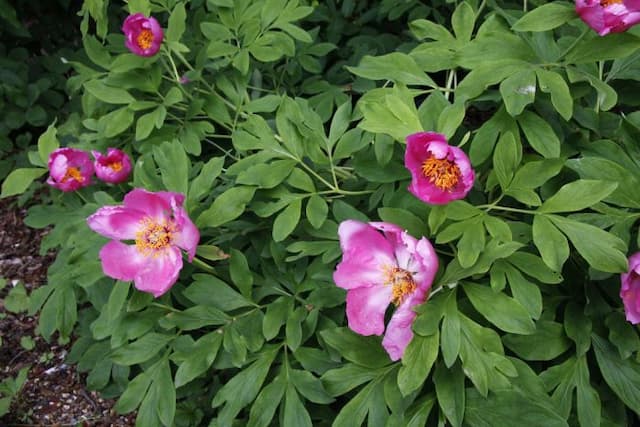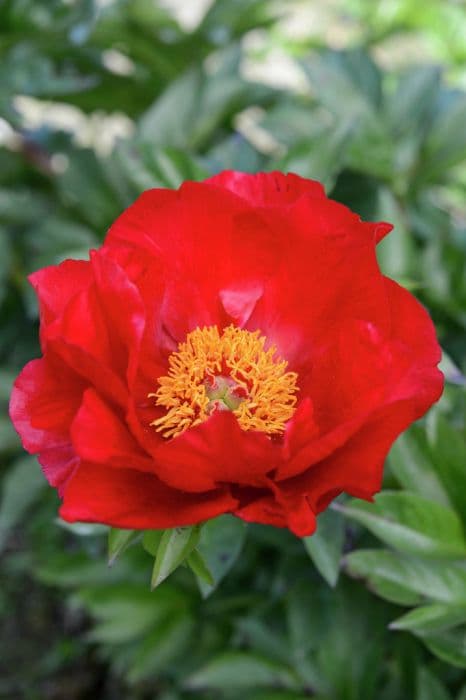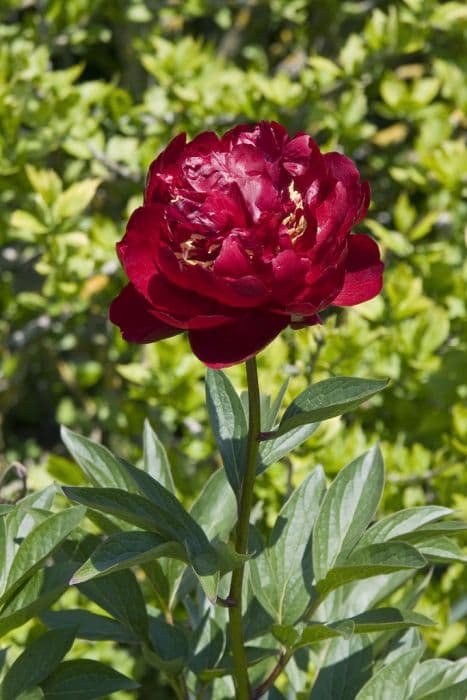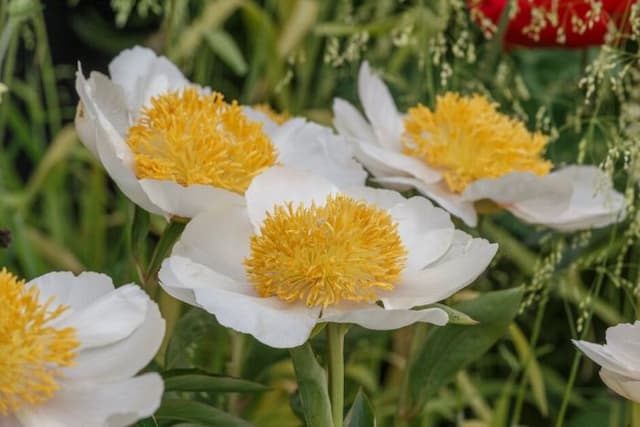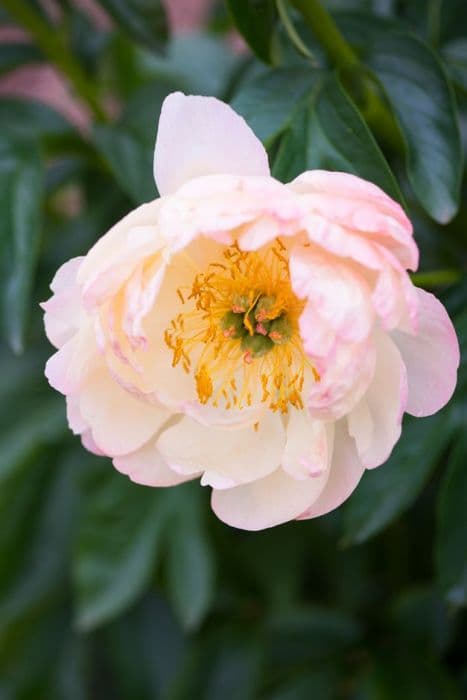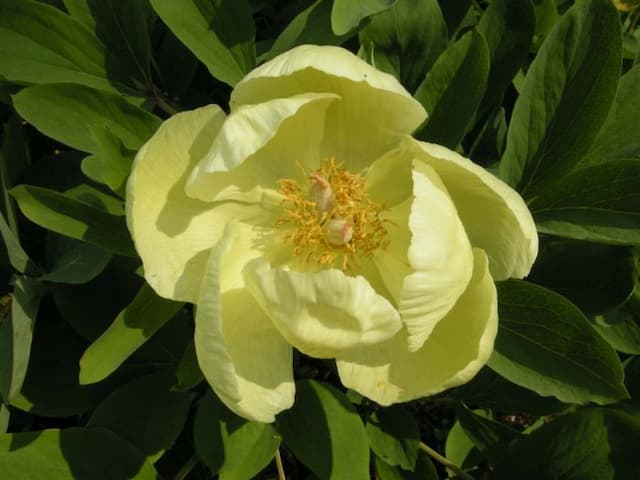White double peony Paeonia × festiva 'Alba Plena' (d)

ABOUT
The plant in question, commonly known as a peony, boasts an alluring display of stunningly large, double rows of silky white petals that radiate outwards from its center, creating a full, lush flower head that is iconic to this type of plant. The blooms offer a striking contrast against the backdrop of the plant's deep green foliage, with each leaf composed of multiple leaflets that are rounded and exude a healthy, vibrant sheen. As a trademark of double-flowered peonies like this one, the densely packed petals may sometimes reveal a hint of a blush at their base, adding a touch of delicate color to the otherwise pure white blossoms. The peony itself is structured with sturdy stems that hold the extravagant flowers aloft, ensuring that their visual impact is noticeable even from a distance. Further enhancing their appeal, these flowers often exude a sweet, enchanting fragrance that is highly esteemed in the gardening world.
About this plant
 Names
NamesFamily
Paeoniaceae.
Synonyms
Double White Peony, Festiva Maxima Peony, White Festiva Peony.
Common names
Paeonia × festiva 'Alba Plena'.
 Toxicity
ToxicityTo humans
The common name for Paeonia × festiva 'Alba Plena' is peony. Peonies are not considered highly toxic to humans. However, ingesting parts of the plant may cause mild gastrointestinal discomfort, including nausea, vomiting, and diarrhea. Generally, peonies do not have serious toxic effects unless consumed in large quantities.
To pets
The common name for Paeonia × festiva 'Alba Plena' is peony. Peonies are considered to be mildly toxic to pets such as dogs and cats. If a pet ingests peony, it may experience mild vomiting or diarrhea. The symptoms are generally not severe, but if a pet consumes a large amount of the plant, more serious gastrointestinal upset may occur. It's always a good practice to keep pets away from peonies and to consult a veterinarian if you suspect your pet has ingested a harmful substance.
 Characteristics
CharacteristicsLife cycle
Perennials
Foliage type
Deciduous
Color of leaves
Green
Flower color
White
Height
2-3 feet (0.6-0.9 meters)
Spread
2-3 feet (0.6-0.9 meters)
Plant type
Shrub
Hardiness zones
3-8
Native area
Asia
Benefits
 General Benefits
General Benefits- Ornamental Value: Adds visual appeal to gardens with its double white flowers.
- Long Bloom Period: The peony has an extended flowering period, providing prolonged garden interest.
- Attracts Pollinators: Attracts bees and other pollinators, supporting biodiversity.
- Hardy Perennial: It is a hardy perennial, capable of withstanding cold winters.
- Drought Resistance: Once established, it has good tolerance to drought conditions.
- Low Maintenance: Requires minimal care beyond the initial planting and settling in period.
- Fragrance: The flowers emit a pleasant fragrance that can enhance the sensory experience of a garden.
- Cut Flowers: The blooms are ideal for use in floral arrangements.
- Cultural Significance: Peonies have symbolic meanings in many cultures, often associated with prosperity and honor.
- Landscape Versatility: Can be used in a variety of garden designs, including borders and as specimens.
 Medical Properties
Medical PropertiesThis plant is not used for medical purposes.
 Air-purifying Qualities
Air-purifying QualitiesThis plant is not specifically known for air purifying qualities.
 Other Uses
Other Uses- Peony petals can be used as a natural dye for fabrics and textiles, adding a gentle pink to blush tone to the materials.
- Floating the blooms in a bowl of water can create a visually appealing centerpiece for special events or as a calming element in a spa setting.
- Pressed peony flowers are often used in crafting, such as creating bookmarks or decorative cards, preserving their beauty in a delicate form.
- The flowers can be candied for an elegant edible garnish on desserts, particularly for wedding cakes or summer treats.
- Peony blooms can be used in potpourri mixtures, alongside other dried flowers and herbs, to impart a light, floral fragrance to a room.
- Dried peony petals can serve as a unique confetti alternative for celebrations, creating a biodegradable and aromatic option.
- Peony plants, with their lush foliage, serve as excellent background plants in floral photography, giving a lush, green contrast to highlight the subject.
- They can be used in wreath-making, with both their foliage and blooms adding a luxurious touch to homemade wreaths.
- Peony petals are sometimes incorporated into artisan bath products such as bath bombs or bath salts for their color and subtle fragrance.
- Artists may use peony blossoms in still life compositions, capturing their full blooms and intricate layers in various media such as oil painting or watercolor.
Interesting Facts
 Feng Shui
Feng ShuiThe Peony is not used in Feng Shui practice.
 Zodiac Sign Compitability
Zodiac Sign CompitabilityThe Peony is not used in astrology practice.
 Plant Symbolism
Plant Symbolism- Prosperity: Peonies, including Paeonia × festiva 'Alba Plena', often represent wealth and good fortune, symbolizing the hope for a prosperous life.
- Honor: They are symbols of honor and high social status, possibly due to their full, round blooms being associated with opulence and regality.
- Romance and Marital Bliss: The lush and romantic appearance of peonies makes them symbols of love, often used in wedding bouquets to wish newlyweds a happy marriage.
- Beauty: Peonies embody the idea of feminine beauty, with their delicate, layered petals and sweet fragrance, evoking the admiration for natural aesthetics.
- Compassion: The softness of the peony's appearance can also represent compassion and nurture, suggesting a gentle and caring nature.
 Water
WaterFor a Peony, such as the Paeonia × festiva 'Alba Plena', watering should be thorough, ensuring that the soil is moist but not waterlogged. It's best to water these plants once a week with about 1 gallon of water per plant, adjusting for rainfall and temperature. During the growing season, if the weather is particularly dry, you might need to water twice a week. However, once the plant is established, Peonies are somewhat drought tolerant and will require less frequent watering. Avoid overhead watering to prevent fungal diseases; instead, water at the soil level.
 Light
LightPeonies, including the Paeonia × festiva 'Alba Plena', thrive in full sunlight, needing at least six hours of direct sunlight daily. The best spot for your Peony would be an area that receives morning light and is protected from the intense afternoon heat. However, they can tolerate light afternoon shade, especially in hotter climates.
 Temperature
TemperaturePeonies such as the Paeonia × festiva 'Alba Plena' prefer temperate climates and are hardy in USDA zones 3 through 8. They can survive winter temperatures as low as -40 degrees Fahrenheit and summer temperatures of about 100 degrees Fahrenheit. However, for optimal growth, the ideal temperature range for Peonies is between 65 and 75 degrees Fahrenheit during the growing season.
 Pruning
PruningPeonies, including Paeonia × festiva 'Alba Plena', should be pruned to remove spent flowers and to shape the plant. Deadheading after blooms fade encourages healthy growth and can prevent disease. In the fall, after the leaves have died back, cut the stems down to within a few inches of the ground. Pruning is typically done annually to prepare the plant for winter and to ensure vigorous growth in the spring.
 Cleaning
CleaningAs needed
 Soil
SoilPeonies prefer well-drained soil with a pH between 6.5 to 7.0. A good soil mix consists of two parts loam, one part peat moss, and one part perlite to ensure proper drainage and aeration. Adding organic compost to the mix can provide essential nutrients for optimal growth.
 Repotting
RepottingPeonies, including the 'Festiva Maxima' variety, are not typically grown in containers and therefore do not require repotting. They are perennial plants that are best planted directly in the garden where they can live for decades without the need for repotting.
 Humidity & Misting
Humidity & MistingPeonies like 'Festiva Maxima' tolerate a wide range of humidity levels and do not require any special humidity considerations. Average outdoor ambient humidity is generally sufficient for their growth and flowering.
 Suitable locations
Suitable locationsIndoor
Peonies, like 'Festiva Maxima,' rarely thrive indoors; they need cold to bloom.
Outdoor
Plant 'Festiva Maxima' in full sun, fertile soil; mulch and water well.
Hardiness zone
3-8 USDA
 Life cycle
Life cycleThe Paeonia × festiva 'Alba Plena', commonly known as the Double White Peony, begins its life cycle with seed germination, which can take several months due to dormancy and may require cold stratification to simulate winter conditions. Upon germination, seedlings develop a small set of true leaves and a tuberous root system. As the plant matures, it enters a vegetative stage where it grows larger foliage and an increasingly robust root system each year. The next stage is the flowering phase, occurring in late spring to early summer, where the plant produces large, fragrant double-form white blossoms that attract pollinators. After blooming, the peony enters a period of seed development if pollination has occurred, leading to seed dispersal in late summer to autumn. Finally, the plant enters dormancy in the winter, with the above-ground foliage dying back, while the root system remains alive underground to regenerate the plant the following spring.
 Propogation
PropogationPropogation time
Spring-early summer
Paeonia × festiva 'Alba Plena', commonly known as Peony, is typically propagated through division, which is best done in the fall after the plants have gone dormant. To propagate by division, carefully lift the peony clump from the ground with a garden fork, being cautious not to damage the roots. Gently shake or wash off the soil so you can see the individual tubers clearly. Using a sharp knife, divide the clump into sections, making sure each section has at least three to five eyes, which are the growth points where new shoots will emerge. Replant each section promptly, positioning the eyes no more than 2 inches (about 5 centimeters) deep in the soil to encourage successful sprouting in the spring. This method allows the newly planted divisions to establish their root systems before the onset of winter, ensuring a stronger start for the next growing season.
